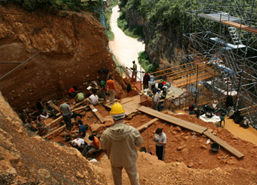Excursion Archaeological Site of Atapuerca and to the MHE
During the afternoon of Monday, June 10, we will take a bus tour to the Archaeological Site of Atapuerca, declared World Heritage Site in 2000. The Sierra de Atapuerca is the cradle of the first Europeans, who lived there for over one million years. We will visit the archaeological sites along the so-called Trinchera del Ferrocarril, where the largest amount of human fossils in the world has been discovered. We will then return to the city of Burgos, to visit the Museum of Human Evolution. There we will meet face-to-face the main human fossils discovered at Atapuerca Sites, and enjoy the innovative and appealing facilities for the study of evolution.
|
MEH A primary goal of the Museum of Human Evolution (MEH) is to establish a modern museum in Burgos not only to accommodate the extraordinary fossils found at the Archaeological Site of Atapuerca, but to explain the scientific disciplines involved in the interpretation of such findings. The MEH also seeks to provide a holistic view of the human presence on Earth, showing the new theories on human evolution. This museum has created a first class interpretative center, attractive to all audiences and provided with a spectacular and symbolic architecture. The modern museography of the MEH is combined with an adequate human team, ready to transmit and translate the interest in paleoanthropology. http://www.museoevolucionhumana.com |
|
|
ARCHAEOLOGICAL SITE OF ATAPUERCA The first discoveries made at the Sierra de Atapuerca in the second half of the nineteenth century suggested the archaeological wealth of the area. Then, the deep and systematic study performed during the last quarter of the twentieth century turned this site into one of the largest in Europe, being its relevance to paleoanthropology unique in the world. Indeed, Atapuerca has changed the record of the human history from the Pleistocene (with human fossils and stone tools dating back to one million years ago) to present time. Also, relevant discoveries have been made about the fauna, flora and climate of the last 1.5 million years of evolution. This complex has been declared a World Heritage Site by UNESCO in 2000, and their three scientific co-directors received the Príncipe de Asturias Award for Scientific Research in 1997.http://whc.unesco.org/en/list/989/ |
|












